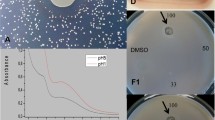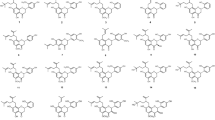Abstract
THE relationship between the toxicity of metal cations and their physico-chemical properties has been considered in terms of electrode potential1,2, insolubility of the metal sulphide3, and electronegativity4. Danielli and Davies4 suggested that the toxicity of metal ions is determined by their ability to form un-ionized complexes with ionogenic groupings at the cell surface, and they have taken the electronegativity values of the metals as a measure of the tightness of covalent binding to these groups. The application of this hypothesis to the toxicity of a number of metal salts to fungal conidia5 has recently been questioned by Miller6. In his examination of my experimental results, Miller has arbitrarily disregarded the toxicities of metals less toxic than zinc by terming them “basically not toxic to fungus conidia” although they all possess measurable ED50 values. It was, of course, precisely to show that the same toxic mechanism may apply to a wide range of metal ions that these less toxic metals were examined.
This is a preview of subscription content, access via your institution
Access options
Subscribe to this journal
Receive 51 print issues and online access
$199.00 per year
only $3.90 per issue
Buy this article
- Purchase on Springer Link
- Instant access to full article PDF
Prices may be subject to local taxes which are calculated during checkout
Similar content being viewed by others
References
Mathews, A. P., Amer. J. Physiol., 10, 290 (1904).
Jones, J. R. E., J. Exp. Biol., 16, 425 (1939); 17, 408 (1940).
Shaw, W. H. R., Science, 120, 361 (1954).
Danielli, J. F., and Davies, J. T., “Adv. in Enzymology”, 11, 35 (Interscience, New York, 1951).
Somers, E., Nature, 184, 475 (1959).
Miller, L. P., Nature, 185, 545 (1960).
American Phytopathological Society, Committee on Standardization of Fungicidal Tests, Phytopathology, 37, 354 (1947).
McCallan, S. E. A., and Miller, L. P., “Advances in Pest Control Research”, 2, 107 (Interscience, New York, 1958).
Somers, E., Canad. J. Bot., 36, 997 (1958).
Pauling, L., “The Nature of the Chemical Bond”, 2nd edit. (Cornell Univ. Press, Ithaca, 1948).
Haïssinsky, M., J. Phys. Radium, (8), 7, 7 (1946).
Howlett, K. E., Sci. Progr., 47, 286 (1959).
(a) Sussman, A. S., von Böventer-Heidenhain, B., and Lowry, R. J., Plant Physiol., 32, 586 (1957). (b) Cochrane, V. W., “Physiology of Fungi”, Chapter 14 (John Wiley, New York, 1958). (c) Rothstein, A., and Hayes, A. D., Arch. Biochem. Biophys., 63, 87 (1956). (d) Davies, J. T., Haydon, D. A., and Rideal, Sir Eric, Proc. Roy. Soc., B, 145, 375 (1956).
Miller, L. P., McCallan, S. E. A., and Weed, R. M., Contrib. Boyce Thompson Inst., 17, 173 (1953).
Author information
Authors and Affiliations
Rights and permissions
About this article
Cite this article
SOMERS, E. Fungitoxicity of Metal Ions. Nature 187, 427–428 (1960). https://doi.org/10.1038/187427a0
Issue Date:
DOI: https://doi.org/10.1038/187427a0
This article is cited by
-
Decreased incidence of mycorrhizal root tips associated with soil heavy-metal enrichment
Plant and Soil (1988)
-
Nickel in plant growth and metabolism
The Botanical Review (1974)
Comments
By submitting a comment you agree to abide by our Terms and Community Guidelines. If you find something abusive or that does not comply with our terms or guidelines please flag it as inappropriate.



